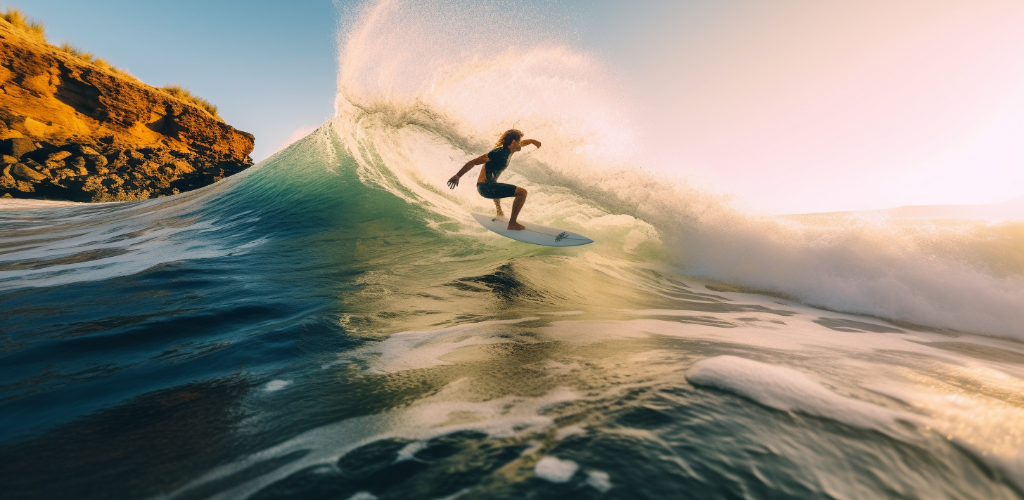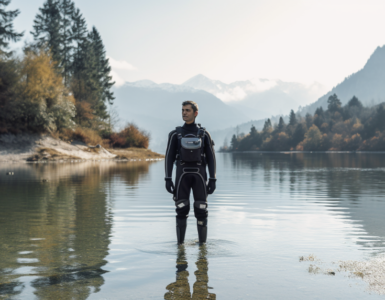For any water sport enthusiast, understanding the difference between surf and swell is not only crucial to improving performance but also to ensuring safety. These two terms might sound similar, and they are indeed related, but they represent different aspects of the sea’s behavior. Knowing how they differ and how they interact can provide a deeper appreciation for the ocean’s complexity and help make the most out of your water sports activities.
Picture this: you’re standing on a beach, watching waves break, feeling the salty breeze on your face, and hearing the roar of the ocean. Now, what you’re seeing and hearing can be divided into two main components – the surf and the swell. But what are they exactly? Let’s dive right in and find out!
Understanding the Basics: What is Surf?
Surf, in the simplest terms, refers to the wave activity happening near the coastline. It’s the breaking waves that we often see and hear when we’re at the beach. These are formed when the energy carried by swells is disrupted by the ocean floor as it becomes shallower, causing the wave to break. Factors like wind, tide, and the shape of the seabed all influence the formation of surf. For water sports enthusiasts, particularly surfers, understanding surf is crucial as it directly influences the quality of the waves they ride.
Diving Deeper: What is Swell?
On the other hand, a swell is a series of waves that are generated by distant weather systems or storms. They are not influenced by the local wind, but by the wind in the area where they were formed. These long, rolling waves travel across the ocean, carrying energy from the place of their origin. When a swell reaches the shoreline, it contributes to the surf. Swells are incredibly important for water sports, as they determine the size and energy of the waves that ultimately form the surf.
A Closer Look at Surf Formation
Ever wondered how surf forms? It’s all about wind. The speed, direction, and duration of wind can dramatically impact surf formation. But how exactly does this phenomenon occur?
The Influence of Local Winds on Surf
Local winds, which are those that blow over a particular region, play a crucial role in shaping the surf. When the wind blows across the surface of the sea, it generates waves. The stronger the wind, the larger the waves, and consequently, the bigger the surf. It’s not just the strength of the wind that matters, though. The direction and duration of the wind also contribute to the formation of surf. A wind that blows consistently from the same direction will produce a more organized and powerful surf.
Now, you might be thinking, “But isn’t all wind the same?” Not quite. Local winds are unique because they are influenced by the topography of the land. This means that the quality and characteristics of surf can vary greatly from one location to another. Fascinating, isn’t it?
The Impact of Fetch on Surf Formation
Let’s now turn our attention to another important factor: fetch. But what is fetch?
Quite simply, fetch is the distance over which the wind blows in a single direction. It’s a crucial element in surf formation. The longer the fetch, the more energy the waves can accumulate, and the larger the surf will be. So, don’t be surprised if you find bigger and more powerful surf in locations with a long fetch.
Understanding the Science Behind Swells
Now that we’ve covered surf, it’s time to talk about swells. Swells are long, rolling waves that travel vast distances across the ocean. They are formed by distant weather systems and can travel thousands of miles before reaching the shore. Swells are classified into local, intermediate, and ground swells, depending on their origin and the distance they travel.
Decoding Swell Periods
But what about swell periods? What are they and why should you care?
A swell period is the time between two successive waves. It’s a key parameter for surfers and other water sports enthusiasts because it provides information about the energy and quality of the swell. A long swell period indicates a powerful, high-energy swell that has traveled a long distance. These types of swells are highly sought after by surfers because they produce the best surfing conditions.
| Wind Condition | Effect on Surf Formation |
|---|---|
| Low wind speed | Produces smaller waves and less surf |
| High wind speed | Produces larger waves and more surf |
| Short duration wind | Produces less organized and less powerful surf |
| Long duration wind | Produces more organized and powerful surf |
| Wind blowing in changing directions | Produces chaotic and less organized surf |
| Wind blowing consistently from the same direction | Produces organized and consistent surf |
The Key Differences Rundown: Surf vs. Swell
Ever wondered what distinguishes between surf and swell? Well, there are a few key differences that set them apart. While both are significant for water sports, their formation, behavior, and impact can be quite different. Let’s go through the main differences between the two.
- Formation: Surf is generally formed by local wind conditions, whereas swell is generated by distant weather systems.
- Behavior: Surf tends to be more turbulent and chaotic, affected by local wind and coastline features. In contrast, swell is more uniform and organized, traveling in well-defined sets.
- Impact on Water Sports: Surf conditions directly influence the breaking waves that surfers ride, while swell conditions are crucial for predicting the size and quality of these waves.
The Interplay Between Surf and Swell
Now, you might be wondering, how do surf and swell interact with each other? The interaction between surf and swell can create diverse conditions for water sports, making each day at the ocean a unique experience.
When a swell reaches a surf zone, it transforms into surf depending on the local conditions. This transformation is often unpredictable and varies with the contour of the ocean floor, wind direction, and tide levels. Therefore, understanding both surf and swell can help water sports enthusiasts anticipate the wave conditions and plan their activities accordingly.
The Impact of Tides on Surf and Swell
Did you know that tides can significantly affect both surf and swell? That’s right! Tides, the rise and fall of sea levels, can dramatically alter the conditions for water sports.
High tides can increase the water depth, causing the swell to break further from the shore, creating softer, slower-breaking waves. Conversely, low tides can cause the swell to break closer to the shore, producing steeper, faster-breaking waves. Therefore, knowing the tide schedule can help water sports enthusiasts choose the right time to enjoy the ocean.
So, there you have it! The world of surf and swell is fascinating, isn’t it? And understanding these concepts is not just about enhancing your water sports experience; it’s also about ensuring safety and making the most of your time at the ocean. So, ready to catch the next wave?
Reading Surf and Swell Reports: A Guide for Beginners
Have you ever wondered what all those numbers and terms mean on surf and swell reports? Well, you’re not alone. Many beginners find these reports quite daunting. But don’t fret, it’s not as complicated as it seems.
These reports provide essential information such as wave height, wave period, and wind direction. Wave height is simply the measurement from the wave’s trough to its peak. Wave period refers to the time it takes for two successive waves to pass a single point. Wind direction, as the name suggests, indicates from which direction the wind is coming.
Understanding these terms and their significance can immensely enhance your water sports experience. Not only will it help you identify the best times to hit the waters, but it will also keep you safe.
Safety Considerations: Understanding Surf and Swell
Speaking of safety, understanding surf and swell is absolutely crucial for anyone engaging in water sports. Different conditions present varying degrees of danger, and being clueless about them can put you in harm’s way.
For instance, a high surf with short wave periods can indicate choppy conditions, which can be dangerous for beginners. Conversely, a low surf with long wave periods suggests smooth and safe conditions suitable for all skill levels.
Remember, the sea is unpredictable and can change rapidly. Therefore, always check surf and swell reports before you head out, and never underestimate the power of nature.
The Role of Surf and Swell in Different Water Sports
Now, let’s discuss the impact of surf and swell conditions on various water sports.
- Surfing: Surfers generally prefer long-period swells as they produce powerful and smooth waves perfect for riding.
- Windsurfing: Wind surfers look for strong winds and high surf to perform their high-flying maneuvers.
- Kayaking: Kayakers usually prefer calm conditions with low surf and swell.
- Bodyboarding: Bodyboarders can make the most out of varying conditions, but generally, they prefer medium surf with moderate swells.
- Stand-up Paddleboarding (SUP): SUP is best enjoyed in calm conditions with low surf and long-period swells.
Remember, these are just general preferences. Different individuals may have different preferences based on their skills and comfort levels.
Conclusion and Key Takeaways
So there you have it, a comprehensive look into the fascinating world of surf and swell. We’ve discussed their formation, differences, and their impact on various water sports. But most importantly, we’ve emphasized the importance of understanding these elements for your safety.
So the next time you’re planning to hit the waters, remember to check the surf and swell reports. Not only will it improve your experience, but it can also save your life. Remember, knowledge is power, especially when you’re dealing with the unpredictable power of the sea. Stay safe out there!




